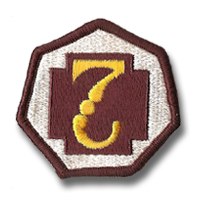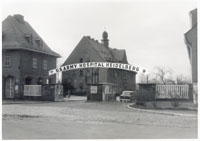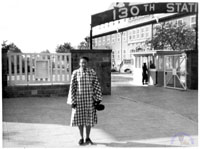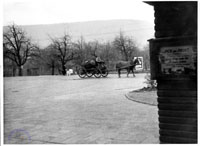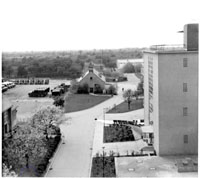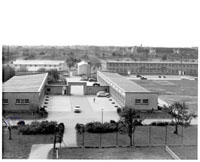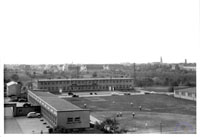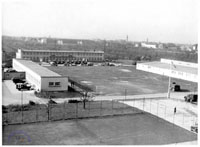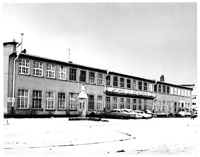| If you do
NOT see the Table of Contents frame to the left of this page, then
Click here to open 'USArmyGermany' frameset |
|||||||||
|
USAH
Heidelberg |
|||||||||
|
|
|||||||||
|
|||||||||
|
|
|||||||||
| USAH Heidelberg History | |||||||||
 Main gate, US Army Hospital, Heidelberg, 1952 |
|||||||||
 Hospital sign in front of entrance to the 130th Station Hospital, 1946 (Webmaster's collection) |
|||||||||
| 1945 - 1946 | |||||||||
| (Source: 130th Station Hospital, Heidelberg; installment of the "Our Army Hospitals" series that appeared in the Medical Bulletin published in USFET during the mid 1940s - probably early 1947.) | |||||||||
| On 15 July 1945,
the 130th Station Hospital, then at Camp
Lucky Strike, Le Havre, France, was assigned to the 7th Army for duty
with the Army of Occupation. It arrived at Heidelberg, Germany, on
1 August 1945, and proceeded to Rohrbach, Germany, a small village
about three miles south of Heidelberg. Here, in the Nachrichten Kaserne,
it took over from the 103rd Evacuation Hospital at 0001 hours, 24
August 1945, the mission of providing station hospital facilities
(750 beds) for the troops in the Heidelberg area. The Nachrichten Kaserne was constructed by the Germans during the period from 1937 to 1939. Upon completion in 1939, it was used to house and train Signal Corps 33. At the beginning of the war in September 1939, Signal Corps 33 moved to the front. From then on, the Kaserne was occupied by infantry and other units. In 1941, the Kaserne was changed to a hospital, whch was kept in operation for nine months. After that it was re-constructed to house different units of approximately 1,500 men each. None of these units was medical. The 103rd Evacuation Hospital, together with a few non-medical units, was the first American group to occupy the Kaserne. The 130th Station hospital operated under practically full field conditions in two large barracks buildings without adequate space and plimbing until the summer of 1946, when a few additional buildings wre completed. The plant, when completed, will consist entirely of renovated buildings and some new construction. The completion date was set originally for October 1946, but shortage of critical material has advanced this date until 31 January 1947. At this writing, it is about 80 percent complete. |
|||||||||
|
|||||||||
| All administrative
offices except post exchange, utilities, special service and motor
pool are located on the first floor of the Headquarters building (Bldg
P). The second and third floors of this building are utilized as Nurses'
quarters. Since the arrival of many dependents, the majority of the
bachelor officers are also quartered on the hospital grounds. The
officers' club and mess are combined on the second floor of Building
O. Another building needing further description is Building D. This
rather long building includes a 500-seat theater, special service
office, information and education offices, library, public address
control system, pressing shop, ice cream bar, post exchange, barber
shop, enlisted men's mess, German mess, motor pool and utility office. The morgue and medical supply warehouse occupy the basement of Building A and linen exchange and unit supply occupy the basement of Building B. The remaining details of the hospital plant are shown in the attached map. The hospital serves the typical station hospital needs of the Heidelberg Area Command which includes personnel of Headquarters Third Army and many army units. Also, patients are received routinely from other large military areas, such as Karlsruhe and Mannheim. In fact, patients are received from as far away as the French Zone. The number of persons entitled to medical service in the area is approximately 10,000. Before the arrival of dependents a complete obstetrical service was added to the hospital facilities and at present time approximately 100 women are attending pre-natal clinics. A very attractive nursery is already in full operation. In November 1946, a 7-chair dental clinic moved into new quarters. The clinic averages about 400 patients a month and approximately 1,200 sittings. The hospital receives and disposes of approximately 800 patients per month, about 3,000 persons were seen by the outpatient services and 1,000 civilian and military physical examinations are conducted each month. During the last quarter of 1946, the hospital was reduced to 500 beds. The close of the year found all activities in their permanent houses with the exception of the laboratory, X-ray, physical therapy, orthopedic clinic, EKG and BMR room, and ear, eye, nose and throat clinic. |
|||||||||
| If you have more
information on the history or organization of the USAH Heidelberg,
please contact me |
|||||||||
|
|
|||||||||
| 1980 | |||||||||
| (Source: USAREUR Medical Bulletin, Vol. 37, No. 9, September 1980) | |||||||||
| The 130th Station Hospital of the Heidelberg Medical Department Activity (HMEDDAC) was activated on Sept 25, 1942 at Camp Barkley, Texas. The hospital's mission was to prepare for overseas duty as a 750-bed station hospital in the European Theater of Operation. The remaining months of 1942 and the early months of 1943 were spent in the assembling of the unit's personnel and equipment and in accomplishing their training.
On July 25, 1943, the hospital moved to the New York Port of Embarkation, absorbed additional personnel, and then, at full strength, sailed for England. The station hospital established itself at Camp Chiselden, Wiltshire, located about 70 miles west of London. There, it assumed the mission of providing station medical service to nearby troop units. After many months of intensive planning and preparation, the Allied Forces, under the command of General Eisenhower, began the invasion of the European continent on June 6, 1944. Nine days later, on June 15, the 130th Station Hospital became a transient hospital in the line of evacuation from the western front. After treating 30,000 patients over the next 10 months, it relocated at Le Havre, France, and provided dispensary medical care to troops deploying to the United States. With the end of the war and the occupation of Germany, the unit transferred in July 1945 to Nachrichten Kaserne in the small town of Rohrbach, about three miles south of Heidelberg. The hospital was then in its permanent home with the mission of providing medical support to the occupation forces. Nachrichten Kaserne had been built in 1934-1936 to house a German signal battalion of approximately 500 troops. Of historical note, General George S. Patton died at the 130th Station Hospital on Dec 21, 1945 as a result of injuries sustained in an automobile accident near Mannheim, Germany. Today, the 130th Station Hospital is the parent unit of the Heidelberg MEDDAC whose health service area encompasses 3,700 square miles and has the mission of providing medical, veterinary, and preventive medicine support through the hospital and its several organizational clinics and medical detachments. The MEDDAC provides medical support to approximately 62,000 military members and their dependents living in the Mannheim, Heidelberg, Karlsruhe, and Worms area of Germany. The HMEDDAC has within its area of responsibility the Headquarters, United States Army Europe and Seventh Army, and the Headquarters, 7th Medical Command which is also a tenant unit on Nachrichten Kaserne. The 130th Station Hospital provides a full range of major medical specialties including internal medicine, pediatrics, dermatology, general surgery, orthopedic surgery, opthalmology, otolaryngology, obstetrics/synecology, anesthesiology, psychiatry, radiology, and pathology. Veterinary services which are provided by the 487th Medical Detachment include veterinary food inspection activities and care and treatment of small animals. The Preventive Medicine Division provides essential preventive medicine, environmental sanitation, and community health nursing support throughout the MEDDAC's area of responsibility. Large health clinics are located in the Mannheim and Karlsruhe communities, and smaller clinics are located in Worms; Germersheim Army Depot; Coleman Barracks, Mannheim; and Gerszewski Barracks, Karlsruhe. Two medical detachments augment the Heidelberg Hospital and Mannheim dispensary. Major backup support for specialty services is provided by the 2nd General Hospital at Landstuhl, the 97th General Hospital at Frankfurt, and the University of Heidelberg Hospital. At present, the 130th Station Hospital has 125 operating beds with an average daily census of 75 patients. Approximately 900-1,000 patients are seen daily on an outpatient basis. Renovation has recently been completed on the troop billets, dining facility, and the clinic building. The main hospital building is scheduled for renovation in the near future. Renovation of the Mannheim and Karlsruhe clinics is scheduled to begin in the coming months. |
|||||||||
| 3rd General Dispensary | |||||||||
|
|||||||||
| 187th General Dispensary | |||||||||
| (Source: Email from Ernest J. Cook, 187th Disp, 1962- 63) | |||||||||
| I was assigned to the 187th Dispensary Unit in Worms, Germany 62-63, I hauled supplies for them and we supported the 8th Mech Inf Div and the 38th Trans Bn. What a darn good bunch of guys there were there and very good medics and Doctors. I was also TDY with the 38th off and on during that time, as the gentleman said in the article about the 38th, the 38th was a very sharp and very military outfit. I always wanted to drive off in one of their 5-tons but they wouldn't let me; just 2-1/2's. I lost my DI many years ago and when I saw that crest the memories flooded back. Would you know of any way possible for me to get another crest? Just remembered, I played ball for the 38th Ramblers -- we were 7th Army bn. runners up in 1962. I volunteered for duty as a driver as much as possible, made the time go faster. I got off a run to Kaiserlautern, just got the truck put away and the duty driver came up and said "TK, your it, all the medics are out on calls; you have got to go pick a woman up on the economy and take her to Hiedelberg." All we had left was the old "Cracker Box," so I got it fired and a new medic just came in, so he went with me. Sure enough, there she sat, very much pregnant. They didnt tell me that, so away we went, just got by the Mannheim cut off and she let out a yell and grabbed my arm. I still got 3 little white fingernail spots, she said I'm having a baby. We said we knew that, just 20 more miles we'll be there. "No, I'm having the baby NOW." I don't know how we did it but we got her in the back, had one army blanket. I looked at the medic and said there you go, and he said: "I'm a combat medic with the 8th just here for training. Don't look at me for no baby." Well I helped pull a few calves before so I figured here goes, and by gosh we delivered that baby and got her to the hospital. Thank goodness there was a medic out on the dock and we showed him what we had and they whooshed her inside and we made a hasty exit to Worms. Next day the CO, Capt. Rammer, called the whole dispensary out and said he had some questions. Two men, one in filthy fatigues showed up at Heidelberg in an old cracker box and had a woman and a baby on an army blanket in the back. I know that somehow TK Cook (they called me "TK" because I was the youngest guy in the outfit and they would always say get the kid to do it) is involved in this. So who is the other man. He looked at us and grinned and said good job. Coming from him that meant a whole lot. A year later when I rotated out, a woman came across the parade ground. She had this little boy by the hand and she told him this is one of the men who helped deliver you. The 187th General Dispensary, Worms, was a satalite of the Heidelberg Hospital. I was assigned there about April of 1962 after a year with the 10th Field Hospital in Wuerzburg. My MOS was medical supply, which in Army terms meant I sat in a deuce and a half and hauled supplies. I remember our CO was Capt. Rammer, Dr. White, and a Phillipino Dr. What a cast of characters was assembled at that dispensary, but I will tell you this, when anyone needed medical attention that was the place to be. Those fellows were super. I believe thier were about 14 Medics there, that little dispensary took care of the 8th Infantry unit, the 38th Transportation Battallion, and a pretty good cast of civilian personnel around the area. Also a squad of MP's, and a signal group. I just look in amazement at the list of units and towns in your web site where I picked up supplies, hauled to or drove through. It was sure a shock to read the article from the geltleman who was with the 38th, and went back to visit and the place is now a shopping mall. I would rather remember seeing the 8th out in formation, what a site. |
|||||||||
|
|
|||||||||
| Related Links: |
|||||||||
